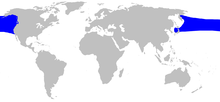- Stejneger's beaked whale
-
Stejneger's beaked whale 
Size comparison against an average human Conservation status Scientific classification 
Kingdom: Animalia Phylum: Chordata Class: Mammalia Order: Cetacea Family: Ziphiidae Genus: Mesoplodon Species: Mesoplodon stejnegeri Binomial name Mesoplodon stejnegeri
True, 1885
Stejneger's Beaked Whale range Stejneger's beaked whale (Mesoplodon stejnegeri), sometimes known as the Bering Sea beaked whale or the Saber-toothed whale, is a poorly-known member of the genus Mesoplodon inhabiting the northern North Pacific Ocean. Leonhard Hess Stejneger initially described the species in 1885 from a skull, and nothing more of the species was known for nearly a century. The late 1970s saw several strandings, but it was not until 1994 that the external appearance was described from fresh specimens. The most noteworthy characteristic of the males is the very large, saber-like teeth, hence the name.
Contents
Description
The body for this species is rather typical for a Mesoplodont, long and tapering at both ends. The beak of the whale is of medium length, and the mouthline forms an arch, though much smoother than other species. The teeth of the males are much larger than those of most other Mesoplodonts and point forwards and inwards right in front of the apex. Only Layard's beaked whale and the Spade-toothed whale have longer teeth. The coloration is overall dark gray to black on the body with light coloration below, and around the head giving it a "helmeted" appearance. The coloration darkens with age, but females have a light pattern on the bottom of the flukes which become more apparent with age. Like most species, scars occur on the males (from other males) and cookie cutter shark bites are present on both sexes. The length is at least 5.25 meters (17 feet 6 inches) for males and 5.5 meters (18 feet) for females. They are likely around 2.1 to 2.3 meters long (7 to 8 feet) when born.
Population and distribution
This is the northernmost species of beaked whale in the Pacific Ocean, ranging up into the Bering Sea. They are distributed along both sides of the Pacific to Miyagi Prefecture, Japan and southern California. They may migrate south in winter. As with most species of beaked whales, no population estimates have been made.
Behavior
The whales are typically found in groups of 3 to 4 and sometimes up to 15 animals in a very close group. The groups may have age and sex segregation. Adult males fight each other extensively, and some specimens have been found with healed jaw fractures.
Conservation
This species has been occasionally hunted in Japan in the past, and occasionally been caught in driftnets. It is uncertain how much this affects the population.
References
- ^ Taylor, B.L., Baird, R., Barlow, J., Dawson, S.M., Ford, J., Mead, J.G., Notarbartolo di Sciara, G., Wade, P. & Pitman, R.L. (2008). Mesoplodon stejnegeri. In: IUCN 2008. IUCN Red List of Threatened Species. Downloaded on 24 March 2009. Database entry includes a brief justification of why this species is of data deficient.
Sources
- Encyclopedia of Marine Mammals. Edited by William F. Perrin, Bernd Wursig, and J.G.M Thewissen. Academic Press, 2002. ISBN 0-12-551340-2
- Sea Mammals of the World. Written by Randall R. Reeves, Brent S. Steward, Phillip J. Clapham, and James A. Owell. A & C Black, London, 2002. ISBN 0-7136-6334-0
External links
Categories:- IUCN Red List data deficient species
- Toothed whales
- Ziphiids
- Mesoplodont whales
- Megafauna
Wikimedia Foundation. 2010.

